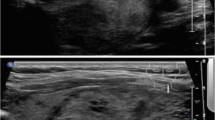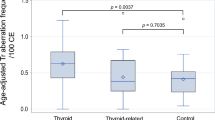Abstract
The Belarus–American (BelAm) thyroid study cohort consists of persons who were 0–18 years of age at the time of exposure to radioactive iodine fallout from the 1986 Chernobyl nuclear power plant accident and who have undergone serial thyroid screenings with referral for fine-needle aspiration biopsy (FNAB) using standardized criteria. We investigated thyrocyte nuclear abnormalities in cytological samples from FNABs in 75 BelAm subjects with single and multiple thyroid nodules and 47 nodular goiter patients from Leningrad, Russia, unexposed to Chernobyl fallout. Nuclear abnormalities examined included internuclear chromosome bridges and derivative nuclei with broken bridges (i.e., “tailed” nuclei), which are formed from dicentric and ring chromosomes and thus may be cellular markers of radiation exposure. Among subjects with single-nodular goiter, thyrocytes with bridges were present in 86.8% of the exposed BelAm cohort compared with 27.0% of unexposed controls. The average frequency of thyrocytes with bridges and with tailed nuclei was also significantly higher in the BelAm subjects than in controls. Among subjects with multinodular goiters, thyrocytes with bridges were present in 75.7% of exposed BelAm patients compared with 16.7% of unexposed controls; thyrocytes with tailed nuclei were observed in all of the BelAm subjects but in only 40% of controls, and the mean frequencies of bridges and tailed nuclei were significantly higher in the exposed group. Unusually, long bridges were detected in 29% of BelAm patients with single-nodular goiters and 35% of those with multinodular goiters, while no such abnormalities were observed among patients from the Leningrad region. In the exposed subjects from BelAm, we also found positive correlations between their estimated dose of Iodine-131 from Chernobyl fallout and the frequency of tailed nuclei (p = 0.008) and bridges (p = 0.09). Further study is needed to confirm that these phenomena represent consequences of radiation exposure in the human organism.




Similar content being viewed by others
References
Achille M, Boukheris H, Caillou B et al (2009) Expression of cell cycle biomarkers and telomere length in papillary thyroid carcinoma: a comparative study between radiation-associated and spontaneous cancers. Am J Clin Oncol 32(1):1–8
Bennett B, Repacholi M, Carr Z (2006) Health effects of the Chernobyl accident and special care programmes, Report of the UN Chernobyl Forum Expert Group “Health”. World Health Organization, Geneva
Gisselsson D (2000) Chromosomal instability and genomic amplification in bone and soft tissue tumor. Lund University, Sweden
Gisselsson D, Pettersson L, Höglund M et al (2000) Chromosomal breakage-fusion-bridge events cause genetic intratumor heterogeneity. Proc Natl Acad Sci USA 97(10):5357–5362
IAEA TR 405 (2001) Cytogenetic analysis for radiation dose assessment: a manual
Kost EA (1975) Handbook of clinical laboratory diagnostic methods. “Medicine”, Moscow
Kravtsov VY, Fedortseva RF, Starkova EV et al (2000) Tailed nuclei and dicentric chromosomes in irradiated subjects. Appl Radiat Isot 3:1121–1127
Kuzovatov SN, Kravtsov VIu, Vakhtin IuB (2000) Internuclear chromosome bridges and nuclear protrusions in rat rhabdomyosarcoma RA-23. Tsitologiia 42(11):1097–1102
Likhtarev I, Bouville A, Kovgan L, Luckyanov N, Voillequé P (2006) Questionnaire- and measurement-based individual thyroid doses in Ukraine resulting from the Chornobyl nuclear reactor accident. Radiat Res 166(1):271–286
Rozhko AV, Masyakin VB, Vlasova NG (2008) Peculiarities of development of thyroid pathology in population exposed in childhood and adolescence. Medical-biological and social-psychological security problems in emergency situations (No. 4):C19–C22
Saad AG, Kumar S, Ron E et al (2006) Proliferative activity of human thyroid cells in various age groups and its correlation with the risk of thyroid cancer after radiation exposure. J Clin Endocrinol Metab 91(7):2672–2677
Stezhko VA, Buglova EE, Danilova LI et al (2004) A cohort study of thyroid cancer and other thyroid diseases after the Chornobyl accident: objectives, design and methods. Radiat Res 161(4):481–492
Takeichi N, Hoshi M, Iida S et al (2006) Nuclear abnormalities in aspirated thyroid cells and chromosome aberrations in lymphocytes of residents near the Semipalatinsk nuclear test site. J Radiat Res (Tokyo) 47:A171–A177
Tronko MD, Bogdanova TI, Komissarenko IV et al (1999) Thyroid carcinoma in children and adolescents in Ukraine after the Chernobyl nuclear accident. Cancer 86:149–156
Tuttle RM, Becker DV (2000) The Chernobyl accident and its consequences: update at the millennium. Semin Nucl Med 30(2):133–140
Zotti-Martelli L, Migliore L, Panasiuk G, Barale R (1999) Micronucleus frequency in Gomel (Belarus) children affected and not affected by thyroid cancer. Mutat Res 440:35–43
Acknowledgments
This work was supported by the Intramural Research Program of the U.S. National Cancer Institute, NIH, DHHS, and the Department of Energy, with initial funds for equipment provided by the U.S. Nuclear Regulatory Program. Support has also been provided by the Ministry of Health of the Republic of Belarus within the limits of Government program performance.
Author information
Authors and Affiliations
Corresponding author
Rights and permissions
About this article
Cite this article
Nadyrov, E., Rozhko, A., Kravtsov, V. et al. Karyopathological traits of thyrocytes and exposure to radioiodines in Belarusian children and adolescents following the accident at the Chernobyl nuclear power plant. Radiat Environ Biophys 51, 187–193 (2012). https://doi.org/10.1007/s00411-012-0407-z
Received:
Accepted:
Published:
Issue Date:
DOI: https://doi.org/10.1007/s00411-012-0407-z




